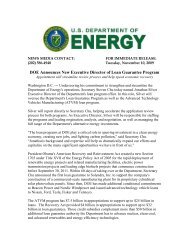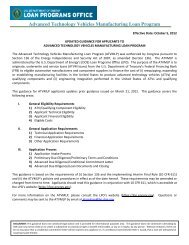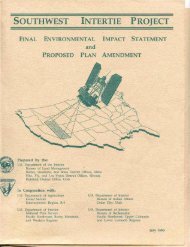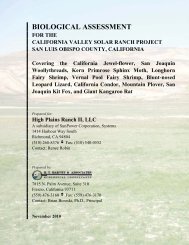Bureau of Land Management's Decision Record and Environmental
Bureau of Land Management's Decision Record and Environmental
Bureau of Land Management's Decision Record and Environmental
You also want an ePaper? Increase the reach of your titles
YUMPU automatically turns print PDFs into web optimized ePapers that Google loves.
Jersey Valley Geothermal Development Project<br />
<strong>Environmental</strong> Assessment: NV063-EAO8-091<br />
conducted during the nesting season <strong>and</strong> it is likely owls would have been observed if present<br />
(GBE 2008). Northern portions <strong>of</strong> the transmission corridor appeared suitable for burrowing<br />
owls. The more extensive sagebrush st<strong>and</strong>s were evidence that these areas were not seasonally<br />
saturated. None <strong>of</strong> the burrows observed showed any signs <strong>of</strong> burrowing owl activity <strong>and</strong> no<br />
burrowing owls were observed during the field survey (GBE 2008).<br />
Townsend’s big-eared bat <strong>and</strong>pallid bat<br />
Townsend’s big-eared bat (Corynorhinus townsendii) is associated with areas containing caves<br />
<strong>and</strong> cave analogs for roosting habitat. Townsend’s big-eared bat requires spacious cavern-like<br />
structures for roosting during all stages <strong>of</strong> its lifecycle (Pierson et al. 1999).<br />
The pallid bat (Antrozous pallidus) breeds in arid deserts <strong>and</strong> grassl<strong>and</strong>s, <strong>of</strong>ten near rocky<br />
outcrops <strong>and</strong> water. It is present but less abundant in evergreen <strong>and</strong> mixed conifer woodl<strong>and</strong>. The<br />
bat will usually roost in a rock crevice or building, <strong>and</strong> less <strong>of</strong>ten in a cave, tree hollow, or mine.<br />
There is a major bat maternity colony <strong>and</strong> hibernaculum located within Sections 27 <strong>and</strong> 34,<br />
T.27N., R.40E. <strong>of</strong> the Jersey Valley Unit Area. The spring areas <strong>and</strong> associated vegetation<br />
provide for foraging habitat. The desert shrub <strong>and</strong> sagebrush vegetation communities also<br />
provide foraging habitat for the Townsend’s big-eared bat <strong>and</strong> the pallid bat (GBE 2008).<br />
The transmission line corridor is located in potential foraging habitat for the Townsend’s<br />
big-eared bat <strong>and</strong> the pallid bat in the Battle Mountain Range, near the Phoenix Mine. However,<br />
no suitable roosting habitat occurs along the transmission line corridor (GBE 2008).<br />
Ferruginous hawk<br />
The ferruginous hawk is a nesting-summer resident <strong>of</strong> the planning area. A number <strong>of</strong> nests have<br />
been recorded over the years. Juniper trees are the preferred nesting sites <strong>of</strong> the ferruginous<br />
hawk, <strong>and</strong> nests are <strong>of</strong>ten constructed in juniper “stringers” which overlook large open areas on<br />
alluvial fans. Prey consists primarily <strong>of</strong> ground squirrels in the spring <strong>and</strong> early summer <strong>and</strong><br />
jackrabbits in late summer <strong>and</strong> fall. Ferruginous hawks are more sensitive to nest disturbance<br />
than most raptors (Stamm 2006). An active ferruginous hawk nest was found within the<br />
transmission corridor in April 2009. Suitable foraging habitat for ferruginous hawks exists<br />
throughout the Project vicinity.<br />
Prairiefalcon<br />
The Prairie Falcon has a body length <strong>of</strong> 15 — 20 inches, a 31/2 foot wingspan, <strong>and</strong> weighs 1 —<br />
2 pounds. Prairie Falcons inhabit hills, canyons, <strong>and</strong> mountains <strong>of</strong> arid grassl<strong>and</strong>s <strong>and</strong> shrub<br />
steppes <strong>of</strong> southwestern Canada, western United States, Baja California, <strong>and</strong> northern Mexico.<br />
An active prairie falcon nest was identified in 2000 within 1 mile <strong>of</strong> the proposed transmission<br />
corridor. Suitable foraging habitat for prairie falcon exist throughout the Project vicinity.<br />
Golden eagle<br />
-48 -







